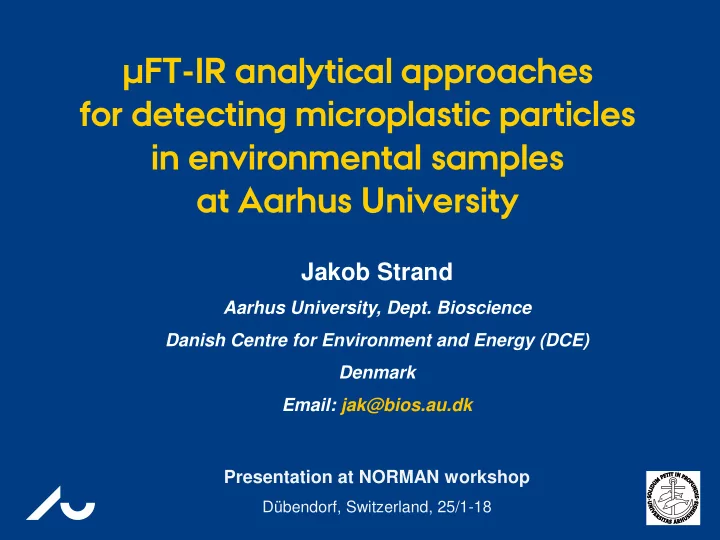

µFT-IR analytical approaches for detecting microplastic particles in environmental samples at Aarhus University Jakob Strand Aarhus University, Dept. Bioscience Danish Centre for Environment and Energy (DCE) Denmark Email: jak@bios.au.dk Presentation at NORMAN workshop Dübendorf, Switzerland, 25/1-18
AARHUS UNIVERSITY Ongoing marine litter (incl. microplastic) activities DEPARTMENT OF BIOSCIENCE Jakob Strand 5. oktober 2017 at Aarhus University We are involved in - Research projects including µFT-IR method developments, - Monitoring and more advisory-oriented projects for the Danish EPA (incl. HELCOM and OSPAR WGs) - Capacity building projects in third world countries (Zanzibar). Marine litter topics includes: Beach litter surveys and source characterisation of macrolitter in Denmark, Greenland and Zanzibar. Plastic particles in biota, e.g. in Greenlandic fulmars and mussels Microplastic, amounts and composition in water column, sediment, biota … and drinking water
AARHUS UNIVERSITY µFT-IR instrumentation DEPARTMENT OF BIOSCIENCE Jakob Strand 5. oktober 2017 Agilent Cary 620/670 microscope with Focal Plane Array (FPA) Available detection modes: Transmission and reflectance 128 x 128 pixels, wavelengths 3800 – 875 cm -1 15 x magnification, pixel size 5.5 x 5.5 µm Field of view: 700 x 700 µm Fast mapping of mosaic consisting of e.g. 64 field of views with area of ~5 x 5 mm = <2 hours (with 16 scans per pixel) In addition. µATR (germanium coated) Prototype 64 x 64 pixel wavelengths 3800 – 875 cm -1 Large Area ATR Pixel size 1.1 x 1.1 µm (Diamond/ZeSe) to be installed Common ATR (GladiATR), 4000 – 400 cm -1 later this year For particles with surface area > 0.5 mm 2
AARHUS UNIVERSITY Microplastic analyses >100 µm DEPARTMENT OF BIOSCIENCE Jakob Strand 5. oktober 2017 Based on a combination of 1) Visual microscopy for chacterisation and quantification of potential MP particles in complex environmental samples Characterisation performed according to JRC (2013). And 2) µFT-IR analyses for validation of selected/representive potential MP particles transferred to a ZeSe disk or MirrIR slide e.g. µFT-IR identification of cellulose-like fibres from blank samples
AARHUS UNIVERSITY Arctic study: Mikroplastic in sediment around Sisimiut city DEPARTMENT OF BIOSCIENCE Jakob Strand 5. oktober 2017 High levels of MP found in areas most impacted by harbour activities, effluents and run-off from city MP also found in samples from other areas except of one of two reference stations Microplastic occur as Fibers, flakes, film, Sisimiut granules, and spherules in various colors NB. Foreløbige resultater
AARHUS UNIVERSITY Microplastic analyses >100 µm DEPARTMENT OF BIOSCIENCE Jakob Strand 5. oktober 2017 Reflectance with MirrIR slide Based on mosaic with several isolated particles
AARHUS UNIVERSITY Composition of microplastic in sediment from sisimiut DEPARTMENT OF BIOSCIENCE Jakob Strand 5. oktober 2017 characterised based on their polymers Dominated by: Polyester (PET), Polyacrylate (e.g. paint flakes) , Polyolefins/polyvinyls, Rubber (e.g. from tyres) n = 154 partikler analyseret med FT-IR Most MP in sediments from Sisimiut consist of polymers with densities >1 g/cm 3 , dvs. more likely to sink to sea floor.
AARHUS UNIVERSITY Microplastic analyses <100 µm DEPARTMENT OF BIOSCIENCE Jakob Strand 5. oktober 2017 Two approaches explored … for now 1) Use of Anodisc membrane filter (0.2 µm): Wavelengths: 3800 – 1300 cm -1 , i.e. more limited First with Anodisc identified as polyacrylate Later with ATR identified as PTFE with trace of acrylate? 2) Settlement of 100 µl particle suspension in ethanol transfered to a ZnSe disk Wavelengths: 3800 – 875 cm -1 Limitation: Difficult to take a small representative subsample from a particle suspension in ethanol
AARHUS UNIVERSITY Some challenges to work on … DEPARTMENT OF BIOSCIENCE Jakob Strand 5. oktober 2017 Reliable quantification incl. assessments of analytical uncertainty and other relevant QA, e.g. using internal standard addition with known reference particles and (internal) reference materials. More automated algorithms for polymer recognition of various types of MP particles in mosaic maps based on chemometric analyses. Establish a functional internal spectra library that is not that expensive, so it can also better can be used for student projects – do you have a suggestion for this ? Thanks for your attention !
Recommend
More recommend